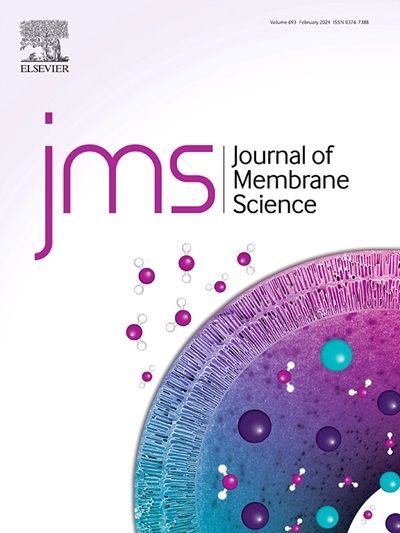IF 8.4
1区 工程技术
Q1 ENGINEERING, CHEMICAL
引用次数: 0
摘要
针对聚多巴胺(PDA)改性超滤膜存在的不足,本研究将多巴胺单体直接加入浇铸液中,以低浓度NaClO溶液为凝固浴,通过非溶剂诱导相分离法制备聚偏氟乙烯(PVDF)/PDA共混膜。结果表明,在相分离过程中,膜的表面和横截面形成了极薄的 PDA 涂层,具有反应时间短、多巴胺利用效率高、操作简单等特点。与 PVDF 膜相比,PVDF/PDA 膜的亲水性和渗透通量同时得到改善,克服了传统 PDA 改性方法所面临的取舍问题。PVDF/PDA 混合膜还表现出更高的机械强度和更多的负电荷。此外,PDA 改性削弱了污物与膜之间的疏水力,增强了静电斥力,从而使污物与膜之间的综合作用力显著降低。反过来,污物与膜之间的相互作用减弱,不仅降低了污物在 PVDF/PDA 膜上的沉积率,而且在清洗过程中更容易剥离膜上积累的污物。因此,PVDF/PDA 混合膜对有机物具有出色的防污能力。本文章由计算机程序翻译,如有差异,请以英文原文为准。

One-step preparation of PVDF‒polydopamine blend ultrafiltration membranes via nonsolvent-induced phase separation and their characterization and antifouling mechanism analysis
To address the existing shortcomings in the polydopamine (PDA) modification of ultrafiltration membranes, in this study, dopamine monomers were directly added to a casting solution, and a low-concentration NaClO solution was used as the coagulation bath to prepare a polyvinylidene fluoride (PVDF)/PDA blend membrane by nonsolvent-induced phase separation. The results revealed that an extremely thin PDA coating formed on the surface and cross-section of the membrane during the phase separation process, which featured a short reaction time, high dopamine utilization efficiency and simple operation. Compared to the PVDF membrane, the hydrophilicity and permeate flux of the PVDF/PDA membrane simultaneously improved, overcoming the trade-off faced by traditional PDA modification methods. The PVDF/PDA blend membrane also exhibited superior mechanical strength and a more negative charge. Moreover, PDA modification weakened the hydrophobic force and strengthened the electrostatic repulsion force between the foulants and the membrane, thereby causing the comprehensive force between the foulants and the membrane to decrease significantly. In turn, the weaker interaction between the foulants and the membrane not only decreased the deposition rate of the foulants onto the PVDF/PDA membrane but also enabled easier peeling off of the accumulated foulants on the membrane during the cleaning process. As a result, the PVDF/PDA blend membrane exhibited excellent anti-fouling ability for organic matter.
求助全文
通过发布文献求助,成功后即可免费获取论文全文。
去求助
来源期刊

Journal of Membrane Science
工程技术-高分子科学
CiteScore
17.10
自引率
17.90%
发文量
1031
审稿时长
2.5 months
期刊介绍:
The Journal of Membrane Science is a publication that focuses on membrane systems and is aimed at academic and industrial chemists, chemical engineers, materials scientists, and membranologists. It publishes original research and reviews on various aspects of membrane transport, membrane formation/structure, fouling, module/process design, and processes/applications. The journal primarily focuses on the structure, function, and performance of non-biological membranes but also includes papers that relate to biological membranes. The Journal of Membrane Science publishes Full Text Papers, State-of-the-Art Reviews, Letters to the Editor, and Perspectives.
 求助内容:
求助内容: 应助结果提醒方式:
应助结果提醒方式:


